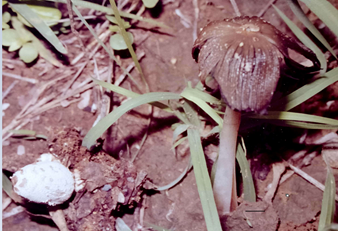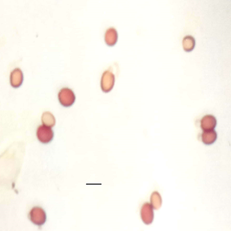Coprinus comatus (O.F. Müll.) Pers.,Tentamen dispositionis methodicae Fungorum: 62 (1797)
MycoBank number: MB 148667; Index Fungorum number: IF 148667; Facesoffungi number: FoF 04984; Fig.1
Basionym: Agaricus comatus O.F. Müll., Fl. dan.: t. 834 (1780)
Synonyms : Agaricus cylindricus Schaeff., Fungorum qui in Bavaria et Palatinatu circa Ratisbonam nascuntur Icones 4: 5, t. 8 (1774) Agaricus vaillantii J.F. Gmel., Systema Naturae 2 (2): 1427 (1792)
Pileus 5.0 – 6.0 cm in diameter, greyish, surface covered with whitish or whitish-grey fibrils, which are flaking , cap ovoid to cylindrical, becoming convex to later flattened, finely sulcate- striate almost to the centre, margin splitting and finally reflexed, fragile, grey basidiocarp covered with shaggy scales, with soon blackening gills, auto-digesting, pileus and appendiculate margins covered with small white, fibrillose scales remnants of the universal veil. Stipe length 5.0– 10.0cm × 0.5– 2.0 cm in diameter, equal, easily separable from the pileus, cylindric with a napiform base, hollow, white, shining , glabrous, fibrous. Lamellae white, free, crowded, at first pinkish- grey, soon black and deliquescent. Spores 5.5–12.0 × 4.5– 7.5 µm, ellipsoidal , olive green to brown and thick-walled . Basidia 4-spored, swollen, clavate to cylindric in shape.
Ecology and distribution– ENVIS Bulletin Himalayan Ecology, Vol 27, 2019 MORPHO TAXONOMICAL AND ECOLOGICAL STUDIES OF MACROFUNGI OF TRANS-HIMALAYAN LADAKH Konchok Dorjey, Punjab——
Specimens Examined – JNV/Mycl/ 1021/2018, by Charu Panwar,, 24°53’18.17″N72°50’52.58″E Sirohi, elevation:321 m (1,053 ft), Mount Abu 72.7083°E 24.5925°N Toad rock area.
Note – Coprinus comatus is commonly called shaggy mane, chicken drumstick mushroom, or lawyer’s wig. It is an edible mushroom and cultivated for consumption but it is edible only in young condition as mature ones are autolysed. It has been reported to be a endoparasitizing nematode-destroying fungus (Hong Luo, et al. (2004) and also as an antioxidant, anticancerous, hepatoprotective, antinflammatory, antidiabetic, antiobesity, antimicrobial, antiviral, antifungal, and antinematode activity ( Li et al. 2010, Sabo et al.2010, Zaidman et al. 2008, Zhang et al.2017, S. Zhao et al.2014, and Zhou & Han, 2008) .

a

b
Fig. 1a Young and mature fruiting bodies growing on dung b Spores Scale bar = 10 µm
